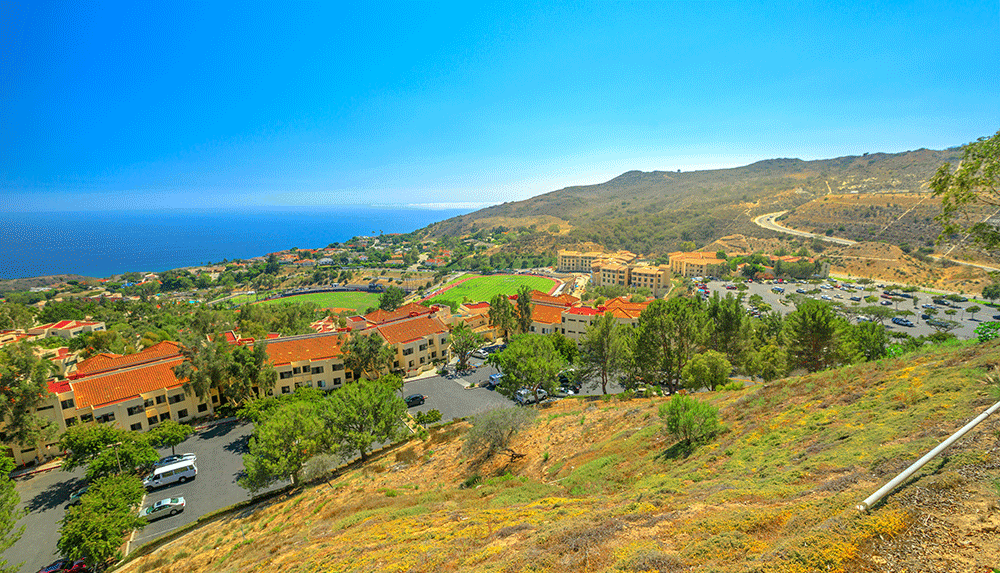This article, originally published on Dec. 11, was updated on Dec. 19 to include additional measures Pepperdine takes to keep students safe while they shelter in place during wildfires.
MALIBU, Calif. — While more than 20,000 Malibu residents were under an evacuation order as a brushfire burned through the area, students at Pepperdine University instead sheltered in place.
The wildfire, dubbed the Franklin Fire, was first reported around 11 p.m. on Dec. 9 along Malibu Canyon Road in the hills north of Pepperdine, LA Times reports. The fire erupted while Southern California was under red flag warnings due to strong winds, low humidity, and dry conditions, NBC News reports.
RELATED ARTICLE: 24 Sonoma State University Dorm Rooms Burglarized during Kincade Wildfire
According to the California Department of Forestry and Fire, the blaze moved at a fierce pace as it was fanned by strong Santa Ana winds. By Dec. 10, at least seven structures had been reported destroyed and another eight damaged. By Dec. 11, the fire had grown to more than 3,800 acres with 7% containment.
While the fire was reportedly 89% contained by Dec. 18, another red flag warning was issued for Los Angeles and Ventura Counties from Dec. 17-18 due to Santa Ana winds of 20-40 MPH and gusts up to 60 MPH accompanied by low relative humidity.
Pepperdine Students Shelter-in-Place in Middle of Campus
For years, Pepperdine spokesperson Michael Friel said the campus, which overlooks the Pacific Ocean and is located in the foothills of the Santa Monica Mountains, has had a special wildfire protocol in place due to its unique terrain and design. The protocol calls for the school’s 3,000 or so students to shelter in place at the Payson Library and the Tyler Campus Center, both of which are located in the middle of campus, according to AP News.
The university began communicating with students about the wildfire around 11 p.m. on Dec. 9 and activated the shelter-in-place order about two hours later. Alerts were sent through text messages, email, and social media. Resident assistants (RAs) also went door-to-door in dormitories to notify students as many were asleep.
“A lot of our students were woken up by a knock on the door, and we made sure they were aware of the conditions and we were able to get them out of harm’s way,” Friel said.
Ryan Song, a resident assistant, said most students remained calm and followed instructions while others rushed to their cars to get off campus. Song said he and other RAs spent several hours running back and forth between the dorms and the main campus to ensure no students were left behind.
RELATED ARTICLE: 9 Ways to Ensure Students Don’t Ignore Emergency Notifications
Classes were canceled on Dec. 10 and final exams were postponed. Friel said no injuries were reported and only one structure was minimally damaged due to firefighters’ hard work and collaboration from students, faculty, and other Pepperdine community members.
Some videos taken by students show trees on fire near the library.
“I was actually sitting at the window where the trees caught fire,” senior Gabrielle Salgado told ABC 7. “I was here earlier when they caught fire, we have palm trees at our park in front of campus. It didn’t spread. Firefighters got it out pretty quickly.”
Pepperdine lifted its shelter in place protocol by the morning of Dec. 10 but students were ordered again to shelter in place around 4:30 p.m. Tuesday.
“Fire activity around Pepperdine’s Malibu campus has greatly diminished as the Franklin Fire has burned through most of the fuel immediately surrounding campus, but some flames are still visible in small pockets of campus,” the university wrote on its website around 10 p.m. on Dec. 10.
The shelter in place was again lifted around 6:48 a.m. on Dec. 11.
“While the Franklin Fire continues to burn in the Santa Monica mountains, active flames remain diminished on the campus, with a few spot fires, and periodic hot spots, all of which are being addressed by fire personnel,” the school wrote.
Pepperdine University Designed with Wildfires in Mind
University officials said the 830-acre campus was designed in the 1960s with fire safety in mind due to the frequency of wildfires in the area. Pepperdine’s Executive Vice President Phil Philips said buildings were intentionally clustered together so if flamers were to reach one set, it would be more difficult for it to spread to the next set. The buildings and have stucco walls and tile roofs. Roadways around the school were also constructed to make ingress and egress easier for firefighters.
In the 1990s, Pepperdine officials worked with Los Angeles County fire officials to develop a safety plan, determining the safest option would be to remain on campus. Phillips said the school is diligent about brush clearance. The landscaping team clears 200 feet of brush around each building, so if a fire does approach campus, firefighters have a defensible space to push back from, the LAist reports. They also try to use fire-resistant plants that are native to Southern California.
The school also has procedures in place to reduce smoke in shelter-in-place locations, such as taping doors shut and using air filters.
Phillips also noted sheltering in place is the safer option since the nearby stretch of the Pacific Coast Highway (PCH) often becomes congested during emergencies, which it did during the 2018 Woolsey Fire. The Franklin Fire also spread across the PCH.
“During the Woolsey Fire back in 2018, it was taking people six hours to get from our campus to the Santa Monica Pier,” Joe Weber, Pepperdine’s Director of Emergency Services and Insurance and Risk, told the LAist. “And so [it’s] much better to keep our community here, and keep all those extra cars out of that congestion to allow other people to use those roads to get out, as well as the first responders to get in.”
That historic fire scorched the area all around the campus but firefighters were able to push it back. No permanent structures were lost and no injuries were reported on campus.
Following the Woolsey Fire, officials realized they needed to communicate quicker with the campus, which was reflected in the school’s consistent and regular updates during the Franklin Fire.
During new student orientation at the beginning of each academic year, the school educates students and other campus community members for what to do in case of a wildfire.













